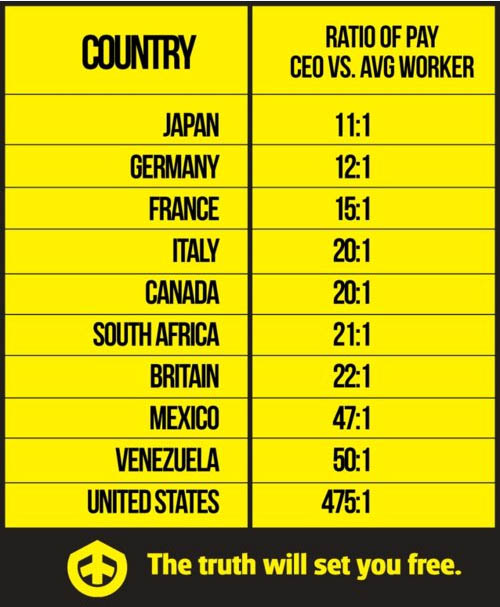I got this from The Progressive Review but since the site did not cite a source, I cannot vouch for the accuracy of the data used to generate it.
Update: See the comment by savannahbarnett below that suggests that the data is unreliable and out of date, although the link to better supported data shows that the ratio in the US is still very high, in the 185 to 325 range.


Hi Mano, it seems to be a chart that came out of a class project that isn’t well cited. PolitiFact did an analysis of it and labeled it “false” (http://www.politifact.com/truth-o-meter/statements/2011/oct/10/facebook-posts/viral-facebook-post-ceo-worker-pay-ratio-has-obscu/) It seems as though there aren’t good numbers on CEO to average worker pay (I don’t believe non-public companies have publish salary data), but there is still an astounding gap in pay.
I can not say anything about the accuracy of the american ratios, (in 2005 they stood at approx. 260 to 1…) but the european ones seam to be correct.
CNN Money says:
The Washington Post has an interesting story about the dynamics of CEO pay. Its lead example is Kevin Sharer, the CEO of Amgen:
Why? In part, because Amgen’s board wanted to pay Sharer more than what 75 percent of his CEO peers are paid, a common approach among corporate boards. However, if all CEOs are going to be paid better than average, that average is going to rise much more quickly than pay-for-performance would dictate.
And then there’s the fact that corporate boards tend to be quite chummy with their CEO, who technically is just an employee of the company.
This is a market that is broken, and those who control it have every reason to insist that it remain broken.
Your data is out of date and not peer-reviewed. Please see the following for a better source…
http://www.epi.org/publication/webfeatures_snapshots_20060627/
PolitiFact is not considered a reliable source for “fact checking” as it has had a long run with continuing mis-statements and poor research…they do not go beyond Wikipedia for level of reliability.
For a peer-reviewed study on the CEO/wage earner compensation ratio, the most reliable and well documented is found at:
http://www.epi.org/publication/webfeatures_snapshots_20060627/
To correct a point you made regarding actual data on CEO compensation;
The Section 953(b) of the Dodd-Frank Act requires public companies to disclose the ratio of the chief executive officer’s compensation (as disclosed in their own Summary Compensation Table) to the annual median employee compensation (calculated as if in the Summary Compensation Table).
These numbers are extraordinarily easy to come by … you just have to go to the company website and start digging (it may require mailing a request for their company prospectus).
Cheers!